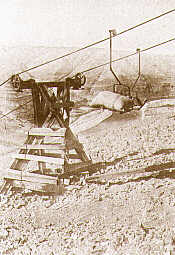
A pylon and grain bucket on the Snake River.
Courtesy of the Washington State University Archives
Grain Chutes and Bucket Tramways
The grain chute, provided one alternative to the lengthy and dangerous wagon trip down the grade roads. C. E. Truax built the first grain chute on the Snake River.1 Truax was both a surveyor and engineer who had served in the army at Walla Walla from 1862 to 1864.2 He settled along the Snake River in 1878 on 600 acres of land that eventually became known as the Truax Bar. He built his grain chute in 1879. This chute, constructed of four inch boards nailed into a square pipe, was 3,200 feet long and dropped 1,700 feet into the river canyon.
Unfortunately, this wooden chute did not solve the immediate problems of grain transportation. Due to the speed at which the grain fell, it became burnt by the friction or cracked and damaged beyond marketability. Truax tried constructing a chute made of tin, coating the inside of his chute with glass and installing side chutes to reduce the speed of the falling grain. None of these approaches really proved successful. There was also the problem of the additional handling needed to use the grain chute. Grain would arrive at the head of the chute in sacks. The grain was taken from the sacks and poured down the chute where it was re-sacked and re-sewn before it could be stacked.
Even with these problems, the partial success of the Truax chute was enough to encourage other local farmers to emulate him. In 1883, L. M. Ringer and J. E. Bishop built a similar grain chute. The Bishop Chute, ran down the Yakiwawa Canyon, on the north bank of the Snake River, ending on Mr. Bishop's land at Bishop Bar.3 Another chute, the Galbreath Chute, was located above Almota and eventually converted to a bucket tramway. The Canyon Chute, located north of the current Little Goose Dam, was the last grain to be built in 1920.
Grain bucket tramways were an alternative to the grain chutes. Bucket tramways consisted of a circular cable running on pulleys supported eight to ten feet off the ground by pylons. The cable had steel baskets or buckets connected at regular intervals, which resembled the seats of a ski lift. Each bucket was capable of carrying one or two sacks of grain. Gravity was used to start the cable in motion. The first bucket, held at the head house, was loaded with rocks. When the bucket was released it pulled the cable and the other buckets, down the hill. As each bucket reached the head house it was loaded with one or two sacks of grain. A sack of grain averaged 140 pounds. Timing was crucial, each sack must be placed carefully to ensure it remained in the bucket all the way down the hill. The workers loaded the buckets without stopping the cable and continued loading from first light until dark during harvest season.
Kelly's Chute began life as a tin grain chute in 1881 and converted to a bucket tramway in 1893. It was in continuous operation until 1929. It had 146 buckets on a 2½ mile long cable and dropped 2,000 feet into the Snake River gorge at Kelly Bar.4
The Interior Grain Tramway, know by some as the Judkins Tramway, operated from 1901 through 1938.5 It was built by Aaron Kuhn in 1901 and sold in 1902 to the Interior Warehouse Company. The Interior Tramway is located on the north side of the Snake River, one half mile down river from Wawawai. There were warehouses at the top and the bottom of this tramway. The drop from the brake house to the river is 1,600 feet. The cable for the Interior Tramway was 12,380 feet long. The cable held 128 buckets each capable of carrying two sacks of grain. According to a local newspaper the tramway cost $11,000 to build and charged $1.00 a ton for shipping.6 This tramway carried an average of 100,000 bushels of grain annually during its thirty seven years of operation.7
Each of these bucket tramways were effective in transporting grain into the river canyon but the most elegant and involved tramway was the rail tramway at Mayview.
1. June Crithfield. in Of Yesterday and the River identifies this man as Charles E. Truax, but Sherfy in This Was Their Time gives his name as Sewell Truax.
2. June Crithfield. Of Yesterday and the River (Pullman, WA: Washington State University Extension Service, 1973), 52.
3. ibid.
4. There is some confusion about the statistics of the Interior Tramway. Cirthfield's Of Yesterday and the River states the Interior Tramway was built in 1890 and had a 1,000 foot drop. An article, "The Interior Grain Tramway", in the Bunchgrass Historian, by Glen Lindeman and Matthew Root, for the National Register of Historic Places, states the Interior was built in 1901 and has a 1,600 foot drop. As Lindeman and Root have substantial source material to support their article I have used their figures and dates throughout.
5. East Wahingtonian (Pomeroy, WA) 15, Oct. 1982.
6. Glen Lindeman and Matthew Root. "The Interior Grain Tramway" in Bunchgrass Historian 17:1 (Colfax, WA: Whitman County Historical Society, Spring 1989). 6.
7. June Crithfield. Of Yesterday and the River (Pullman, WA: Washington State University Extension Service, 1973), 56.
Introduction
Geography
• Farming
• Transportation
• Grain Chutes
• Mayview Tramway
Bulk Handling
• Conclusion
• Bibliography
• Oral Interviews
• Maps
• Illustrations
Acknowledgements
• Comments
![]()